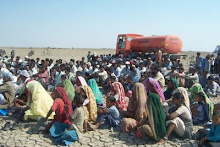Counterview: Gujarat: Thursday, 28th Dec 2023.
Unemployment is one of the severe and burning issues of our time. The government is celebrating Vibrant Gujarat, where one of the focuses for attracting investment is generating employment opportunities.
Surprisingly, the forest
department of Gujarat has snatched away livelihood of more than 1,200 Agariyas
or salt farmers by banning their entry into the Little Rann of Kutch. They all
are part of communities consisting such as Chunvaliya Koli, Sandhi, Miyana, all
de-notified tribes, mostly landless and dependent solely on salt harvesting for
their bread and butter.
By not allowing them to enter the Little Rann, the forest department has pushed these communities further towards marginalization, and probably to hunger.
Gujarat produces above 76% of India's total salt production. Agariyas, traditional salt farmers of Gujarat, have been harvesting salt in the Little Rann, which contributes around 20% of the total produce. They have a history of 600 years of salt harvesting in the Little Rann. Its evidence is well documented in historical documents like the Saurastra Gazettier and the Kathiyavad Sarva Sangrah.
Agariyas migrate to the Little Rann, along with their families in the month of September, and their farming season continues till April or May. The Little Rann is a 5,000 sq km area between Kutch, Patan, Morbi and Surendranagar districts which, turns into a water body for four months of the year and a mud dry desert for 8 months. Temperature during the day rises up to 50 degrees centigrade, while during night it falls to 4 or 5 degrees. They toil hard in scorching heat and shivering cold to add taste to our meal.
The Little Rann was declared Wild Ass Sanctuary in 1973. Wild asses have been conserved very well here, and its population has grown to over 6,000 in the past 50 years.
However, the government has failed to undertake survey and settlement of rights of the Agariyas and other communities as the per provision of the Wild Life Protection Act, because of which they is still termed as "illegal" encroachers and are given notices of eviction periodically. Such unrecognised status poses threat of eviction and loss of livelihood in the community.
Last year, the Agariyas were evicted from certain parts of the Little Rann. The sanctuary department declared that only those Agariyas whose name is included in the survey and settlement report would be allowed. That resulted is the exclusion of 90% of the traditional Agariyas.
The sanctuary department asked for documentary evidence of the possession of land. The fact that the Little Rann has always been an unsurveyed land, and even the government does not have revenue record of this area, was neglected while pressing Agariyas for producing documentary evidence of their ownership or possession of land.
A few months back, Agariyas across 4 districts and 7 talukas got together and made series of representations to their elected representatives and to the administration at district and state levels. They started meeting their MLAs and the ministers concerned. They also made representations to the National Green Tribunal (NGT) and the High Court, where cases regarding the Little Rann were being heard.
Finally, on the 4th of September 2023, a decision was made by the state, that all traditional Agariyas would be allowed to continue salt harvesting upon simple registration, the verification of which would be done during on-site survey. It was also decided that the survey and settlement process list would be revised by doing on-site survey so that seasonal user rights were recognised on a permanent basis.
The registration process was done in all the blocks, and in September many Agariyas moved to the Little Rann. Surprisingly, for no reason, the Agariyas from Santalpur and Adesar areas were asked not to go the Little Rann and were told that their decision would be taken soon.
"The forest department told us that they need some time to verify and finalize the list ... thus we were waiting. However, the forest department has still not allowing us to enter the Rann areas. We do not have any other source of livelihood and today sit ideal at home," says Narubhai Koli from the Santalpur Rann.
“While our fellow Agariyas in Dhangadhra, Patadi, Halvad, Maliya, blocke have already moved into the Rann two months back and their salt harvesting has started, we are not allowed to even make our salt farms ready. When decision was done for the entire Little Rann, we do not understand why such discrimination is done only with us?” he asserts.
Narubhai is farming salt since 6 generations and is disappointed with such dual and selective approach of the government. He adds, "We have been making repeated representations to both our MLA as well as to the forest department. However, they even refuse to give us anything in writing on the reason for refusal of entry.”
Another traditional Agariya Sultanbhai narrates, “When asked under the Right to Information (RTI) for transferring application from the state to the district forest officer (DFO), the latter declared that the decision for Santalpur and Adesar is completely in the hands of Gandhinagar officials."
"So our request is toggling between the Dhrangadhra DFO office and the principal chief conservator of forest’s (PCCF’s) office, Gandhinagar”, he adds.
With no other optional left, the Agariyas are now planning to go on protest before the forest department, Gandhinagar.
Unemployment is one of the severe and burning issues of our time. The government is celebrating Vibrant Gujarat, where one of the focuses for attracting investment is generating employment opportunities.
 |
| Agariyas represent to Patan district collector |
By not allowing them to enter the Little Rann, the forest department has pushed these communities further towards marginalization, and probably to hunger.
Gujarat produces above 76% of India's total salt production. Agariyas, traditional salt farmers of Gujarat, have been harvesting salt in the Little Rann, which contributes around 20% of the total produce. They have a history of 600 years of salt harvesting in the Little Rann. Its evidence is well documented in historical documents like the Saurastra Gazettier and the Kathiyavad Sarva Sangrah.
Agariyas migrate to the Little Rann, along with their families in the month of September, and their farming season continues till April or May. The Little Rann is a 5,000 sq km area between Kutch, Patan, Morbi and Surendranagar districts which, turns into a water body for four months of the year and a mud dry desert for 8 months. Temperature during the day rises up to 50 degrees centigrade, while during night it falls to 4 or 5 degrees. They toil hard in scorching heat and shivering cold to add taste to our meal.
The Little Rann was declared Wild Ass Sanctuary in 1973. Wild asses have been conserved very well here, and its population has grown to over 6,000 in the past 50 years.
However, the government has failed to undertake survey and settlement of rights of the Agariyas and other communities as the per provision of the Wild Life Protection Act, because of which they is still termed as "illegal" encroachers and are given notices of eviction periodically. Such unrecognised status poses threat of eviction and loss of livelihood in the community.
Last year, the Agariyas were evicted from certain parts of the Little Rann. The sanctuary department declared that only those Agariyas whose name is included in the survey and settlement report would be allowed. That resulted is the exclusion of 90% of the traditional Agariyas.
The sanctuary department asked for documentary evidence of the possession of land. The fact that the Little Rann has always been an unsurveyed land, and even the government does not have revenue record of this area, was neglected while pressing Agariyas for producing documentary evidence of their ownership or possession of land.
A few months back, Agariyas across 4 districts and 7 talukas got together and made series of representations to their elected representatives and to the administration at district and state levels. They started meeting their MLAs and the ministers concerned. They also made representations to the National Green Tribunal (NGT) and the High Court, where cases regarding the Little Rann were being heard.
Finally, on the 4th of September 2023, a decision was made by the state, that all traditional Agariyas would be allowed to continue salt harvesting upon simple registration, the verification of which would be done during on-site survey. It was also decided that the survey and settlement process list would be revised by doing on-site survey so that seasonal user rights were recognised on a permanent basis.
The registration process was done in all the blocks, and in September many Agariyas moved to the Little Rann. Surprisingly, for no reason, the Agariyas from Santalpur and Adesar areas were asked not to go the Little Rann and were told that their decision would be taken soon.
"The forest department told us that they need some time to verify and finalize the list ... thus we were waiting. However, the forest department has still not allowing us to enter the Rann areas. We do not have any other source of livelihood and today sit ideal at home," says Narubhai Koli from the Santalpur Rann.
“While our fellow Agariyas in Dhangadhra, Patadi, Halvad, Maliya, blocke have already moved into the Rann two months back and their salt harvesting has started, we are not allowed to even make our salt farms ready. When decision was done for the entire Little Rann, we do not understand why such discrimination is done only with us?” he asserts.
Narubhai is farming salt since 6 generations and is disappointed with such dual and selective approach of the government. He adds, "We have been making repeated representations to both our MLA as well as to the forest department. However, they even refuse to give us anything in writing on the reason for refusal of entry.”
Another traditional Agariya Sultanbhai narrates, “When asked under the Right to Information (RTI) for transferring application from the state to the district forest officer (DFO), the latter declared that the decision for Santalpur and Adesar is completely in the hands of Gandhinagar officials."
"So our request is toggling between the Dhrangadhra DFO office and the principal chief conservator of forest’s (PCCF’s) office, Gandhinagar”, he adds.
With no other optional left, the Agariyas are now planning to go on protest before the forest department, Gandhinagar.
















.jpg)
.jpg)
.jpg)
.jpg)













No comments:
Post a Comment